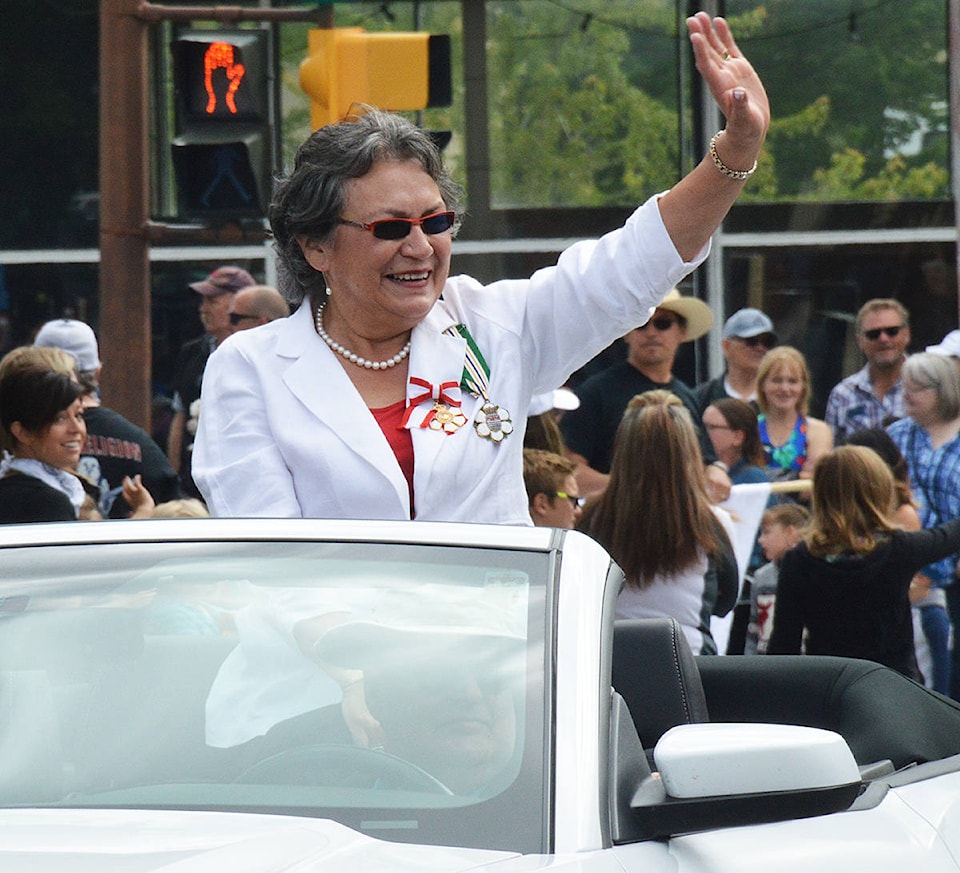Celebrating National Aboriginal Day and framing the 150th anniversary of Confederation in the context of Indigenous peoples was the topic of a presentation from a local Ktunaxa Nation leader to the Chamber of Commerce on Wednesday.
Sophie Pierre, a former chief of the ?aq’am (St. Mary’s Band) community, addressed the members of the Chamber for National Indigenous Peoples Day to talk about the significance of celebrating Indigenous language, culture and being mindful of how Confederation affected Indigenous peoples.
Pierre, who was appointed to the Order of Canada in 2016 in recognition for her work as Chief Commissioner of the BC Treaty Commission and the economic development of First Nations, also highlighted the renaming of the new Cranbrook to Wardner trail — now known as the Chief Isadore Trail — on Wednesday morning.
Chief Isadore was a celebrated leader of the Kutenai band who led his people through a period of change in the mid-1800s as miners, farmers and the RCMP — led by Col. Sam Steele — settled into the area and the traditional Ktunaxa territory.
“I hope that what we can do, is whatever archaeological material that was brought out, or any archaeological study that was done,” Pierre said, “can become a part of that trail, so that you have that history, and I hope that between the community of ?aq’am, the Ktunaxa Nation and the City of Cranbrook that we can figure that out.”
National Indigenous Peoples Day, formerly known as National Aboriginal Day, was first proclaimed on June 13, 1996.
“That was done because there was getting to be a growing awareness that Canadians in general really didn’t have a good understanding about our own history, and when I say our, I’m talking about Canadian history,” said Pierre.
“That our history starts 150-200 years ago is just not right. That’s ripping us off, because our history starts thousands of years ago.”
The day marks an occasion to honour not just Indigenous peoples, but a chance to educate the rest of Canada about that history, Pierre added.
“It gave us an opportunity as Indigenous people to celebrate who we are and to celebrate it with a lot of pride, because that was always not possible,” Pierre said. “It gave us an opportunity to lift off this blanket that had been put over Indigenous people by the residential schools, had been put over us by public education. Because even when we were in school, we didn’t learn about Ktunaxa.”
Pierre singled out School District 5, specifically in Cranbrook, and praised district staff for their efforts in making sure students have the opportunity to learn about Ktunaxa history and culture in Cranbrook and throughout the nation’s traditional territory.
While Canada celebrated National Indigenous Peoples Day on Wednesday, the country is also gearing up for Canada Day and celebrating 150 years of Confederation. Pierre noted that for Indigenous peoples across the country, celebrating Canada Day can come with some mixed, or even negative feelings.
“When you talk about Confederation, think about what Confederation meant to the Indigenous population, to ourselves right here,” Pierre said. “It affected our language, our culture, it took away our land, took away our children. It had a lot of really, really bad effects.
“But we don’t have to stay in that place.”
From infringement and encroachment of traditional Indigenous territories to taking children from families and putting them in residential schools, there are reasons why Indigenous peoples may be hesitant to celebrate Canada 150.
“In order to move on, you must own what has happened in the past,” Pierre continued. “So in Canada 150, in this year, what I think is really going to be necessary for us to move on as Canadians, and for everyone to be able to benefit and to have the kind of life we all want for our children and our grandchildren, is to own our past, and you have to understand it in order to own it.
“To know that there are some pretty legitimate reasons why there are a group of people who are not too happy this year, but that doesn’t mean they shouldn’t be brought into the Canadian family, to be happy from here on in for the next 150 years.”
Take the St. Eugene Golf Resort and Casino, for example; the main hotel structure was originally built in 1910 and used as a residential school that operated under the government’s assimilation policy for 60 years.
The school was closed in 1970 and abandoned in 1974 for 20 years, until Pierre, chief of the ?aq’am at the time, drove the process from the Ktunaxa to restore the building and turn it into a hotel and golfing resort.
The conversion of that building, with its legacy of Indigenous repression, is now a major economic generator and 100 per cent owned by the Ktunaxa Nation.
“We took ownership of our history, we took ownership of where our place has been in this Canadian Confederation quite some time ago, and I’m really, really proud of our nation for having done that,” said Pierre. “And so, we describe some of the things we are able to do now — our celebration — because we are celebrating. We’re celebrating National Aboriginal Day, and we will celebrate Canada Day.
“…Because we’ve started to reclaim who we are as indigenous people, who we are as Ktunaxa, then we are able to embrace our friends and neighbours who live within our traditional territory, share with you our history and our culture and invite you to learn the language, invite you to use those words that have been spoken in this place for thousands of years.”
